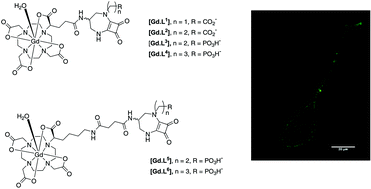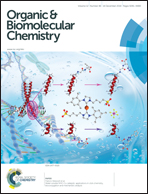Magnetic resonance and optical imaging probes for NMDA receptors on the cell surface of neurons: synthesis and evaluation in cellulo†
Abstract
A second generation of N-methyl-D-aspartate (NMDA) receptor-targeted MRI contrast agents has been synthesised and evaluated in cellulo, based on established bicyclic NMDA receptor antagonists. Their use as responsive MR imaging probes has been evaluated in suspensions of NSC-34 cells, and one agent exhibited significant enhancements in measured longitudinal and transverse water proton relaxation rates (19 and 38% respectively; 3 T, 298 K). A biotin derivative of the lead compound was prepared and the specificity and reversibility of binding to the NMDA cell surface receptors demonstrated using confocal laser scanning microscopy. Competitive and reversible binding of glutamate to the receptors was also visualised, suggesting that the receptor-targeted approach may allow MRI to be used to monitor neuronal events associated with modulation of local glutamate concentrations.


 Please wait while we load your content...
Please wait while we load your content...